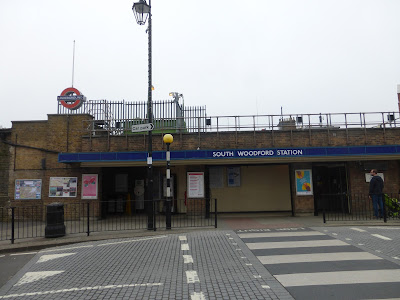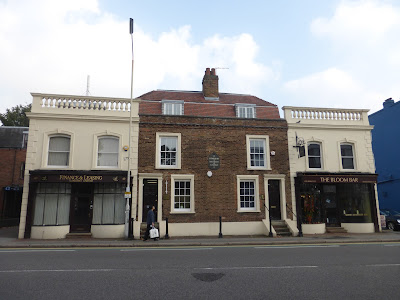This is the 7th station on the Central line that I have visited. The station was originally called George Lane when it opened in 1856 as part of the Eastern Counties Railway. The name was changed in 1937 and then in 1947 it became part of the London Underground Central line when the service was extended from Leytonstone to Woodford.

I walked across the brightly painted bridge to exit the station onto George Lane East. On my right I could see where the Coffee Tavern used to be whilst in front of me was the Railway Bell which opened in 1880.
A short walk down George Lane brings me to the crossroads with Chigwell Road. Dominating this road junction is a large house known as Eagle House. With the arrival of the railway so came the wealthy merchants from London building their large Victorian mansions. It has now been converted into flats which is not unusual with these large buildings. However, this one is of particular interest to fellow blogger. Diane B from Adventure before dementia who lived in the top flat as a child before emigrating to Australia in 1949.
I wonder if Dianne remembers this stained glass panel in the window.
Diagonally opposite the house is the Holy Trinity Church
After visiting the church I walked back towards the station to explore the western side of Woodford South.
The road takes you over the railway line.
Eastern entrance to the station
I am now walking back along the High Road which connects South Woodford and Woodford Green. This large pub has been here since 1827 and overlooks the Green
This flower and gift shop took my eye as the colourful flowers covered the space outside the shop.
St Mary's church was first recorded on this site in 1177. The oldest part of the current church is the tower built in 1708. A new church was added to the original building in 1817 and extended again in 1891 to cope with the expanding population but was destroyed by arson in 1969. Fortunately the silver and registers dating back to 1558 were saved. The new building was completed in 1972.
In front of the church is the grave of William Morris Senior, the father of William Morris(1834-96), artist, textile designer, poet and member of the Pre Raphaelite brotherhood.

The Morris family lived in Woodford Hall, next to St Mary's from 1840-1847. Woodford Hall had been the manor house for centuries but was demolished in 1900. Today the parish Memorial Hall, built in 1902 stands in its place.

There was an antiques fair on when I visited which meant I was able to have a peep inside.
Also on the High Road is Elmhurst, one of a number of large mansions built in this area. It dates from 1771 and was built for a wealthy London merchant. By 1969 three tower blocks had been built in the grounds as halls of residence for Queen Mary College and the old house has been converted to offices. The halls were sold for development in 2003.
The site now includes a library and gym.
The High Road crosses the very busy North Circular Road (A406). It is 25 miles long and together with the South Circular Road forms a ring road for London. It doesn't quite make a complete circuit though, as you have to cross the Thames in the East on the Woolwich Ferry. The motorway M25 however does make a complete circuit of London.
On the bridge above the road are three sculptures that reflect South Woodford's connection with its proximity to Epping Forest. The structures are 7m high, made from stainless steel and are topped by large leaf shapes. Also by Tim Ward are these commemorative benches.


There are four benches and each one has a different theme.

The theme of this one is William Morris who spent his childhood in Woodford.

This one has images of Sir Winston Churchill who was the MP (member of Parliament) for Woodford from 1924-64.
Sylvia Pankhurst (1882-1960), the suffragette came to live in Woodford in 1924 - 1956. She was the second daughter of Emmeline Pankhurst, the founder of the Suffragette movement.

Images of South Woodford taken by the local photography group in 2012

Most of the shops are the usual ones you would find in most towns but this one was a little different. Inside there were jars and jars of old fashioned sweets.
 |
| On the corner of George Lane and High Road is the George. There has been an inn on this site going back to 1657. The present one dates from early 18th cent. |
Continuing along High Road you will see the Odeon cinema built in 1935 and is now a grade II art deco listed building
The car dealership next to the cinema is another art deco building.
A little further down the road is this building which dates from the reign of George II (1727-60) and at some point in its life, was the South Woodford post office.
I walked back to George Lane on my way back to the station. There are shops on both sides of the road with the Electric Parade erected in 1925 on the left.

At the end of the George Lane is the Western entrance to the station.




































That is so neat that you found the bloggers old house. I would love roaming around inside Charlie's.
ReplyDeleteI just love this series that takes me down memory lane. You are very close to where I used to spend a lot of my time working and visiting pubs, Chigwell and Barkingside (where Barnardo's Village and Head Office is). xx
ReplyDeleteI am enjoying this series of posts as I always find local social history fascinating.
ReplyDeleteI am enjoying this series of posts as I always find local social history fascinating.
ReplyDeleteI like the benches but it was a bit hard to absorb after the Diane bombshell.
ReplyDeleteHow handy for the firefighters to slake their thirst at the Railway Bell after returning to the fire house from a fire!
ReplyDeleteSo many interesting things to comment on, but finding Dianne's childhood home takes the cake. She must have been very small when she left. I wonder if she remembers it.
I lived there for the first 6 years of my life. I do remember it quite well. I also visited it in 1970.
DeleteWho would not love to live where there is " The Lovely Shop" and "the Sweet Emporium". ...all your needs right there )))! I love the Ladies Waiting Room at the station. And the benches and sculptures ... This was a nice stop! I love this series. Wish I could ride along with you!
ReplyDeleteSo sorry it took so long for me to comment but I have been away for nearly a week. The old house is so familiar even though I was only a child when I lived there. I remember There were trees surrounding the house and a little garden at the back but that looks like it has gone. I do remember the stained glass window it was the bathroom. During the war the widows were blown in and we sheltered in the cellar. I was only a toddler but I remember the wardrobe had fallen onto Mum and Dad's bed. I remember George Lane, my mum did the shopping there. Once I was bitten by a bee outside the Bakery. The bakery was humming with bees. Thanks again for including my old home.
ReplyDeleteVery small world. My parents owned Eagle House (purchased as a deceased estate) and sold up to move to Melbourne when I was 6 months old (1986).
ReplyDeletedo you know any history of the house?
Delete